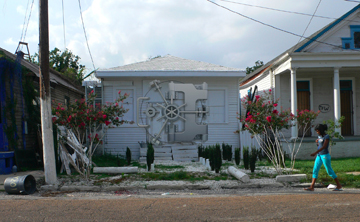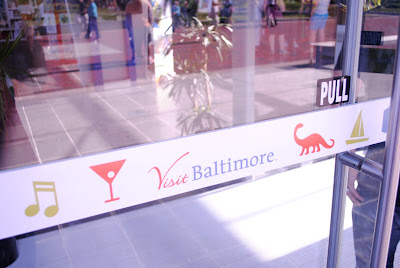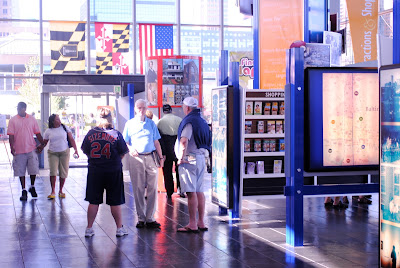I won't take the easy route and claim the entire North Side of St. Louis is suffering unimaginably. Those fearful of anything "North of Delmar" would be well-advised to check out
Old North St. Louis, one of St. Louis's most exciting stories of revitalization and community reinvestment. Even though it's the most often cited North City neighborhood for tales of urban regeneration, Old North does not have a monopoly on the moniker "the future is north" by any means.
Hyde Park has seen several measures designed to stop the outward flow of residents and to plug the loss of irreplaceable historic buildings.
Blue Shutters Development,
Better Living Communities, and
Sun Ministries are just some of the groups in Hyde Park attempting to make a difference for both the built and social environments. Sponsored by the Pulitzer Foundation for the Arts and the Contemporary Art Museum of St. Louis, artist
Theaster Gates is attempting to heal the neighborhood through arts and education.
With the same development and financing team as Old North's 14th Street Mall restoration project (known as Crown Square), the resurrection of
Dick Gregory Place in the Greater Ville is no less exciting. There are stable North City neighborhoods as well who have not seen the worst of decline. These include Academy, the Lindell Park area of JeffVanderLou, Visitation Park, Baden, etc.
Yet much too large swaths of the North Side continue to slip away, losing a valuable sense of place.
The most recent news is that four houses in College Hill burned. One of the four was occupied, and was a complete gem. See 859 Cowan, pre-fire, below:
In the Post-Dispatch story, their photograph of the fire shows the extent of the damage to this particular home. Thankfully, no one was hurt.
Four homes burning within blocks of one another is more than suspicious. Arsonists are likely the culprits here, considering that the three vacant homes had no utility hookups.
Arson, brick rustling, and simple demolition-by neglect are forever denying generations of St. Louisans enjoyment of some of the city's oldest and, at one time, most charming neighborhoods. College Hill is but one struggling North City neighborhood; St. Louis Place, much of JeffVanderLou, the Vandeventer neighborhood, the Ville proper--all are very significant historic neighborhoods that are literal shells of their former selves. JeffVanderLou, in particular, just saw a
devastating round of arsons back in March. Then there's an eight year history of NorthSide project visionary Paul McKee, Jr's holding companies' neglect of its properties. So widespread was this neglect that blogger Rob Powers was able
to catalog over 200 days of blog posts worth of destruction.
In certain North Side neighborhoods, I wonder if there will be much of a physical infrastructure left to save in the next ten years.
St. Louis Place is already infamous for its expansive urban prairie.
This web site and several other St. Louis built environment blogs focus quite often on St. Louis's healthiest neighborhoods or those seen as having the most potential. Benton Park, Benton Park West, the Grove, the Central West End, and yes, Old North St. Louis, are pretty popularly blogged areas of the city these days. In some ways, it's to be expected that a St. Louis blogger will focus on where the most "news" is, or where the best photographs/stories come from. Even those bloggers that like to point out areas of improvement in the city generally look to some gaping holes in otherwise stable streetscapes and neighborhoods.
It's clear that we have an imperative to focus considerable attention on some of the North Side's most distressed neighborhoods. Now, will historic preservation alone lift up neighborhoods that have witnessed disinvestment and flight of people and businesses for decades now? No, quite simply. But, for a hypothetical moment, make the city a mirror image. Soulard is a pockmarked neighborhood ringed with unsuccessful attempts at housing low-income residents. It's now undergoing a remarkable resurgence of the pieces of its built environment that remain. It's our Old North. Today's St. Louis Place and JeffVanderLou are nearly 100 percent intact and now thriving; they're our Benton Park and Benton Park West. O'Fallon is our Tower Grove South. Baden is our Carondelet.
In this mirrored image of St. Louis, we must see the value in saving Benton Park. Our chopped up Soulard is still worth saving, and is seeing rehabilitation, so let's not write off neighboring Benton Park off either. So if we flip back, we see the importance and potential of JeffVanderLou, or College Hill, or St. Louis Place. They should be neatly woven into the fabric of the rest of the city, but they're not. Their hopes of a Benton Park-style revival are slim because of their isolation.
We can't wait around for a NorthSide development proposal, which is too big, or a North 14th Street renaissance, which was very specialized and hard to replicate.
First of all, we need more preservation advocacy specifically focused on the North Side's most sensitive areas. With few people in St. Louis speaking to the importance of these areas, it's easy to see why there's no push to save/repopulate these neighborhoods. It would be nice to see Landmarks Association of St. Louis open a satellite office in Hyde Park or College Hill, renovating and occupying a storefront in the process. Such an action would show that these neighborhoods have great architectural and social value and deserve reinvestment.
Second, we need more leadership like Antonio French, of the 21st Ward. French has partnered with the group
Rebuilding Together to tackle vacancy and blight in the Penrose neighborhood. His
"Block by Block" program is a great model that can spread to other neighborhoods in surrounding wards. French is also attempting to curb gang violence in his ward, is regularly seen cleaning up O'Fallon Park, and introduced Preservation Review in his ward. While staging alley and park cleanups as well as hosting prayer vigils for crime victims might seem like minute steps, French is investing his confidence in his neighborhood and ward. French is very wise to invite the presence of Rebuilding Together into the 21st Ward. The full force of St. Louis's non-profit arm should be applied to ailing North City. If St. Louis is one of the most giving cities in the country
as certain studies show, surely we can channel some of this energy toward addressing systemic poverty and blight in North City (and beyond). Non-profits will take notice of sound leadership and will hopefully respond with the same confidence that the area's leadership projects. Our leaders, but also bloggers like me, must shift the dialog about North City from its crime/violence to "ideas" "hope" "opportunity" and "improvement" in earnest. This means working with and for, not in spite of, neighborhood residents.
We need to install cameras on targeted city blocks. These cameras could catch criminals in the process of robberies, assaults, and other crimes. Cameras could definitely help put an end to arson and brick rustling in some of St. Louis's most tattered neighborhoods. All parties caught illegally demolishing properties and selling off their bricks should be prosecuted to the fullest extent of the law. They're literally stealing a building. Antonio French is already at work to bring cameras to the 21st Ward, at least.
We need philanthropic investment in North City. In New Orleans, there was a corporate-sponsored event called "Christmas in July" where employees of large firms downtown would take a couple days off and assist in renovations of historic properties in a then-rundown neighborhood. Why not do this in North City, HOK? Anheuser-Busch InBev? Monsanto? Enterprise? Et cetera. I proposed in a
previous post that the Gateway Foundation, the bankrollers of Citygarden downtown, fund a citywide greening program to install mature trees on barren blocks. Imagine a Citygarden-scale investment in targeted areas of North City--$40 million dedicated to renovating LRA properties, installing new lighting, neighborhood banners, etc.
Speaking of the LRA, we need to market vacant properties better. Again, I turn to Antonio French, who
created a website to market city-owned properties in his ward. The LRA should also have a bricks-and-mortar storefront, either downtown or in both North and South City, that would inform would-be buyers of what is required of them as well as offer technical assistance in purchasing and renovating properties.
Realistically speaking, most of presently fallow North Side land won't be built upon anytime soon, right? Yet I see Detroit get boatloads of attention for its mostly empty neighborhoods and all of the opportunities they offer in terms of art installations and urban farming. I wonder why St. Louis's most neglected neighborhoods don't generate the same interest, nationally and locally. The St. Louis PR machine rightfully, it would seem, focuses on the city's vibrant and up-and-coming neighborhoods, but our most struggling areas are the ones that need idea factories. It would be great to see St. Louis University and Washington University, among others, bringing art installations to empty North City blocks. Detroit artists literally
froze a house to very visibly tell the tale of what foreclosures do to an urban neighborhood. And a New Orleans artist bought up a whole block of the St. Roch neighborhood and transformed each house into something of an outdoor art showcase, renovating one of the shotguns for her own residence. We need more of this type of eye-catching activity in some of our abandoned neighborhoods.
The "Safe House" in New Orleans--an interactive art exhibit advocating for clean soil in polluted areas of the city. It is one house on a whole block dedicated to outdoor/indoor interactive art in a destitute New Orleans neighborhood. Image Source:
Art:21 Blog
We could do both at once--that is, create artful built environments and fill in vacant lots. Habitat for Humanity St. Louis is currently constructing several dozen homes in Old North. In that neighborhood, Habitat consulted a strong neighborhood association to get a sense of what type of design for housing that neighborhood residents would see as reflective of their community. The result of that interaction
was a thoughtful play on Old North's architectural heritage, with small, but contemporary shotguns as well as two-story flounder houses. Maybe North City residents could be sold on the
concept of container houses, which are growing in popularity worldwide.
A simple shipping container house in Atlanta, Georgia. Image Source:
G Living
In College Hill, and other North City neighborhoods like it, we need to plug the loss of place and start filling these parts of the city with a constant stream of ideas. We have creative, thoughtful people engaged already in the betterment of our city. How do we use them to create a sense of energy and possibility directed at the least successful of St. Louis's neighborhoods? What are your ideas?



















































